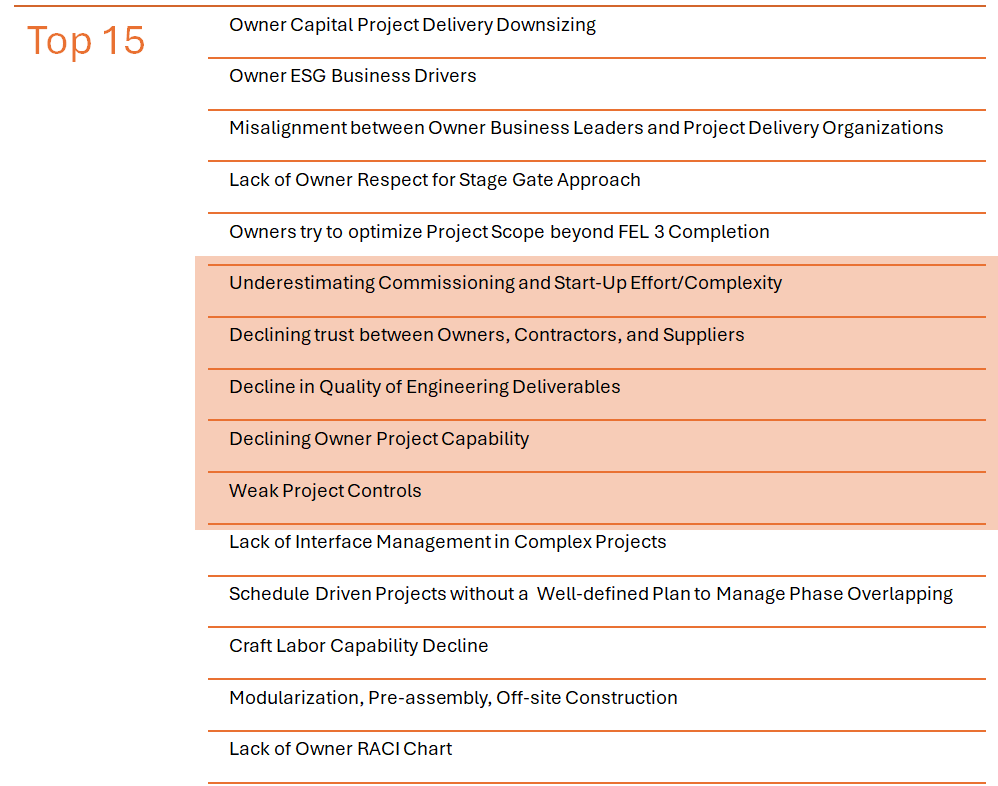In our ongoing series on project management disruptors, we continue to explore the key changes reshaping the landscape of project management. Understanding and adapting to these disruptors is essential for staying ahead in the field. In this edition, we focus on disruptors 6-10, providing insights and strategies to effectively manage these challenges.

Sixth - Underestimating Commissioning and Start-Up Effort/Complexity
Often, the complexity of asset system start-up is misunderstood and planned too late in the execution process. This oversight can lead to delays in handover to operations and a change in business value due to late realization of product sales. To address this challenge, consider the following strategies:
- Early Planning: Integrate commissioning and start-up requirements into the overall execution approach during FEL2 and FEL3 stages.
- Advanced Work Packaging: Implement advanced work packaging to enhance systems planning, which subsequently influences construction completion requirements, thereby determining the timing for procurement and engineering deliverables.
- Clear Communication: Ensure clear communication between construction and operations teams to facilitate smooth transitions.
Seventh - Continuing Decline in Trust Between Owners, Contractors, and Suppliers
The decline in trust has been a constant problem across the industry, resulting from poor stakeholder alignment, combative contracting arrangements, limited risk sharing, and poor transparency. To rebuild trust, organizations can:
- Collaborative Environment: Aim to foster a collaborative win-win environment where all parties share aligned goals. Operate as 'One Team' instead of distinguishing between owners, contractors, and suppliers. Healthy Risk Sharing: Establish healthy risk-sharing practices as part of the overall project execution plan and contracting strategy. Sharing in the benefits of a well-executed project but also share in the costs or projects that do not go as planned.
- Transparent Reporting: Improve transparency and reporting of project deficiencies to foster trust and accountability.
Eighth - Decline in Quality of Engineering Deliverables
This issue stems from misalignment between business drivers and engineering quality, inadequate engineering skill sets, and disrespect for time commitments. To improve the quality of engineering deliverables, consider:
- Business/Engineering Alignment: Create a strong alignment between business and engineering during the FEL1/FEL2 stages. Effectively communicate this alignment to the engineering team to provide clear 'guard rails' for their work. Skill Development: Invest in developing engineering skill sets to meet industry quality standards.
- Time Management: Honor agreed-upon milestones and delivery requirements to ensure timely project completion. Treat schedule commitments as mandatory deadlines rather than suggestions, enabling other activities to proceed on time.
Ninth - Reduced Owner Project Capability
Many owner organizations have downsized their project delivery teams, leading to limited planning and execution capability. Additionally, owner teams often struggle to transition from contractor roles to owner responsibilities, causing confusion and interference with contractor activities. To enhance owner project capability and address the lack of appropriate project experience, organizations can:
- Sourcing Qualified Resources: Source qualified owner resources with appropriate owner project experience to strengthen the team.
- Clear Roles and Responsibilities: Clearly define the roles and responsibilities for owner teams, distinguishing them significantly from those of contractors. This clarity will facilitate effective interfacing with contracted third-party resources and ensure efficient project management. Training and Development: Invest in training and development programs to build owner team capabilities and facilitate smooth collaboration between owner and contractor teams.
- Effective Interface Management: Implement effective interface management practices to improve communication and collaboration. Focus on developing the human skills of project management that foster teamwork and integration.
- Continuous Improvement: Implement continuous improvement initiatives to enhance owner team capabilities and project outcomes.
By addressing these areas, organizations can significantly improve their project delivery capabilities and ensure successful project execution.
Tenth: Weak Project Controls
Weak project controls can significantly hinder the successful execution and delivery of projects. Project controls encompass the processes, tools, and methodologies used to manage and monitor project performance, ensuring that projects are completed on time, within budget, and to the required quality standards. When project controls are weak, several issues can arise… lack of visibility, inconsistent reporting, poor risk management, inefficient resource allocation and inadequate change management. To address weak project controls, organizations can:
- Implement Robust Monitoring Tools: Utilize advanced project management software and tools to enhance visibility and tracking of project performance.
- Standardize Reporting Practices: Establish standardized reporting practices to ensure consistency and reliability in communication.
- Strengthen Risk Management Processes: Develop comprehensive risk management strategies to proactively identify and mitigate potential risks.
- Optimize Resource Allocation: Implement efficient resource management practices to ensure optimal use of time, money, and effort.
- Enhance Change Management: Develop clear change management protocols to effectively handle changes in project scope, schedule, or budget.
Strengthening project controls can improve project performance, reduce risks, and achieve successful project outcomes.
By understanding and addressing these disruptors, organizations can better navigate the evolving landscape of project management, ensuring successful project outcomes and maintaining a competitive edge in the industry. Stay tuned for the final article in this series, where we will explore disruptors 11-15.

